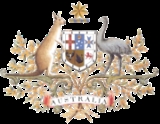
Commonwealth Electoral Act 1918
Encyclopedia
The Commonwealth Electoral Act 1918 replaced the Commonwealth Franchise Act 1902
which defined who was allowed to vote in Australian federal elections
. The Commonwealth Electoral Act comprehensively rewrote the Franchise Act and introduced instant-runoff voting
, known in Australia as Preferential Voting. Preferential voting, which was pioneered by Queensland in 1892, replaced first-past-the-post voting
.
The Single Transferable Vote
was introduced for the Senate in 1949, and the qualifying age for voting was lowered to 18 in 1973
. Indigenous Australians
were granted the right to vote at a federal level in 1962
.
In 1984
the Australian House of Representatives
was expanded by 24 seats and the Australian Senate
by 12 seats. A Senate ticket voting system was introduced and also the grace period after an election is called before the electoral rolls
are closed was extended to seven days.
Commonwealth Franchise Act 1902
The Commonwealth Franchise Act 1902 was an Act of the Parliament of Australia which defined who was allowed to vote in Australian federal elections. The Act granted Australian women the right to vote at a national level, and to stand for election to the Parliament...
which defined who was allowed to vote in Australian federal elections
Elections in Australia
Australia elects a legislature the Parliament of the Commonwealth of Australia using various electoral systems: see Australian electoral system. The Parliament consists of two chambers:...
. The Commonwealth Electoral Act comprehensively rewrote the Franchise Act and introduced instant-runoff voting
Instant-runoff voting
Instant-runoff voting , also known as preferential voting, the alternative vote and ranked choice voting, is a voting system used to elect one winner. Voters rank candidates in order of preference, and their ballots are counted as one vote for their first choice candidate. If a candidate secures a...
, known in Australia as Preferential Voting. Preferential voting, which was pioneered by Queensland in 1892, replaced first-past-the-post voting
Plurality voting system
The plurality voting system is a single-winner voting system often used to elect executive officers or to elect members of a legislative assembly which is based on single-member constituencies...
.
The Single Transferable Vote
Single transferable vote
The single transferable vote is a voting system designed to achieve proportional representation through preferential voting. Under STV, an elector's vote is initially allocated to his or her most preferred candidate, and then, after candidates have been either elected or eliminated, any surplus or...
was introduced for the Senate in 1949, and the qualifying age for voting was lowered to 18 in 1973
1973 in Australia
-Incumbents:*Queen of Australia – Elizabeth II*Governor General – Sir Paul Hasluck*Prime Minister – Gough Whitlam*Premier of New South Wales – Sir Robert Askin*Premier of South Australia – Don Dunstan*Premier of Queensland – Sir Joh Bjelke-Petersen...
. Indigenous Australians
Indigenous Australians
Indigenous Australians are the original inhabitants of the Australian continent and nearby islands. The Aboriginal Indigenous Australians migrated from the Indian continent around 75,000 to 100,000 years ago....
were granted the right to vote at a federal level in 1962
1962 in Australia
-Incumbents:*Monarch – Elizabeth II*Prime Minister – Robert Menzies*Governor General – William Sidney, 1st Viscount De L'Isle-State Premiers:*Premier of New South Wales – Robert Heffron*Premier of Queensland – Frank Nicklin...
.
In 1984
1984 in Australia
-Incumbents:*Queen of Australia – Elizabeth II*Governor General – Sir Ninian Stephen*Prime Minister – Bob Hawke*Premier of New South Wales – Neville Wran*Premier of South Australia – John Bannon*Premier of Queensland – Sir Joh Bjelke-Petersen...
the Australian House of Representatives
Australian House of Representatives
The House of Representatives is one of the two houses of the Parliament of Australia; it is the lower house; the upper house is the Senate. Members of Parliament serve for terms of approximately three years....
was expanded by 24 seats and the Australian Senate
Australian Senate
The Senate is the upper house of the bicameral Parliament of Australia, the lower house being the House of Representatives. Senators are popularly elected under a system of proportional representation. Senators are elected for a term that is usually six years; after a double dissolution, however,...
by 12 seats. A Senate ticket voting system was introduced and also the grace period after an election is called before the electoral rolls
Electoral register
The electoral roll is a listing of all those registered to vote in a particular area. The register facilitates the process of voting, helps to prevent fraud and may also be used to select people for jury duty...
are closed was extended to seven days.

